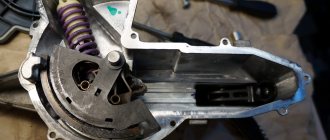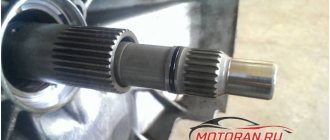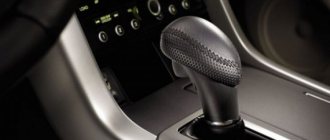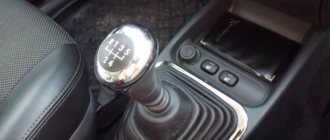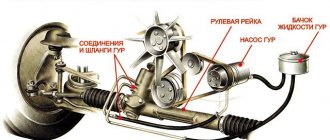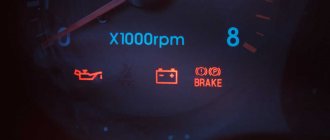When operating a vehicle, it is necessary to monitor the functions of each unit and vehicle systems. Experienced drivers can understand the condition of the transmission of a running car by the nature of the sounds produced by each mechanism. Listening to the car is carried out both while driving and when the car is stopped. A working automatic transmission makes almost no extraneous knocking, noise, squeaks, vibrations, etc. If the automatic transmission is noisy, diagnostics must be carried out to prevent damage to the components and parts of the gearbox.
Noise in automatic transmission when cold: reasons
If the problem only appears when it’s cold, you can still drive, but when the gearbox does not stop making noise even when the unit is warmed up, then specialist intervention is necessary. Delay may result in serious damage.
The cause of the noise when the box is not yet warmed up is especially often the jamming of the generator pulley clutch. You can try opening the hood and driving back or forward a little. It will be clearly visible how the transmission belt jerks.
Typically, drivers immediately change the belt and tension pulley. Yes, the problem may be in them, but you still need to inspect the pulley first. To check it, you need to rotate the pulley several times, first in one direction and then in the other direction. If the pulley does not move smoothly when turning, it will have to be replaced. Work here for 10 minutes.
Why does first gear howl in an automatic transmission?
Sometimes the gearbox hum only appears when driving in first gear. When switching to the second, the unpleasant sound disappears. This means that the problem is in the planetary gear, or rather, in one of its satellites - a group of gears. Over time, the howl of the automatic transmission in first gear only becomes stronger. This leads to transmission scattering and complete engine stop.
The planetary gear needs to be repaired. You can, of course, not rush into a trip to the service station and wait for the mechanism to completely collapse, but such a delay can hurt your wallet. A complete replacement of a planetary gear is more expensive than repairing one of its planetary gears.
By the way, if an unpleasant sound appears only during forced (fixed) transmission, then there is no need to rush into repairs. Try changing the working fluid. But if the noise also appears while driving, this is a serious matter.
What to do if a hum begins to come from the box?
The best solution in this situation is to immediately go to a good service station to obtain information about the nature of this hum. If a specialist, after diagnostics, says that wear has begun on the main pair or other gears of the box mechanism, you can safely drive for a few more weeks, collecting money for repair work. But remember that wear on the main pair shaft sometimes has a negative impact on the condition of all gearbox mechanisms. So you may well get the situation to the point where your box will have to be sent for major repairs or even replacement. The box repair algorithm is as follows:
- bring the car for a quality service with a sufficiently large number of specialists and good equipment for repairs;
- To begin, order disassembly and complete detailed diagnostics of the gearbox to identify problems;
- If you identify a problem, estimate the cost of restoring the car and potentially repairing your box;
- make a decision based on the proposed facts and provided information from specialists;
- Order gearbox repairs from professionals whom you completely trust - poor quality repairs cannot be tolerated;
- install only original expensive parts inside the box, as they can last a long time and have a guarantee.
One of the most expensive processes in transmission repair is disassembly and diagnostics. Then everything is done at affordable service station prices. You need to keep this in mind when choosing parts for your transmission. It is best to use original factory spare parts to completely eliminate troubles in the near future. This way you will save on subsequent repairs and can easily complete the necessary tasks in one process of disassembling the box. You should not skimp on parts and the quality of work performed, as this may negatively affect the operation of the unit. We suggest considering the reasons for the hum in the box, which experts talk about:
Automatic transmission hums at speed: what to do?
There may be a buzzing noise in the area of the gearbox when accelerating. As a rule, the automatic transmission hums at a certain speed limit, and then the hum only intensifies. A detailed diagnosis reveals that the place where the noise is generated is the rear part of the automatic transmission, where the connection to the driveshaft occurs. In this case, the system does not generate any errors. This is not yet a reason to panic, and the appearance of unpleasant sounds in this area is not evidence of the “death” of the gearbox. A possible cause is a broken transfer case front bearing (the bearing closest to the front driveshaft).
With such a malfunction, almost all bearings in the transfer case need to be replaced. For repairs, the box will have to be dismantled. The problem is that the transfer case is located in the same unit with the automatic transmission.
Repair procedure:
- dismantling and disassembling the transfer gear;
- accurate determination of the causes of the malfunction;
- bearing replacement;
- flushing the transfer case housing;
- reassembly;
- adding working fluid to the hydraulic transformer.
What's the result?
As you can see, automatic transmission noise is often a sign of a malfunction, rather than natural wear and tear of the unit. In this case, the hum in the automatic transmission is the basis for stopping the operation of the vehicle and conducting in-depth diagnostics.
You need to understand that normally the automatic transmission should not hum or make noise; only a monophonic sound is allowed, which is uniform. If, against the background of the normal sound of the operating unit, extraneous noises begin to be heard, this indicates problems with lubrication or malfunctions of automatic transmission parts.
Finally, we note that the habit of listening to the sounds and noises of the transmission, engine and other units allows you to identify problems at the initial stage when certain signs first appear. In the case of automatic transmissions, this allows you to avoid serious problems and significantly save the money needed to repair the automatic transmission.
Automatic transmission hums when accelerating
Sometimes the car makes unpleasant sounds when starting to move. Perhaps it's the automatic transmission whining. It starts making noise when shifting into third gear or at a speed of 60 km/h. With further acceleration, the unpleasant noise intensifies. After reaching a certain speed (80-90 km/h), the sound from under the hood subsides. If you stop pressing on the gas, the sound will no longer appear, but further acceleration will provoke its appearance again.
Replacing the rear gearbox can solve this problem. It is also worth inspecting the rear brake discs. You need to check the back side (where the brake cylinder is located). Rusty deposits may accumulate on the discs. If their width is more than 1 centimeter and they are over the entire surface, this may cause extraneous noise. The problem is solved by cleaning the inside of the disks.
Automatic transmission whine when shifting gears
Sometimes when you start driving, you can hear a suspicious sound resembling a howl from under the hood. This usually happens when shifting into second gear. In most cases, the source is the front planetary gear. This unit begins to make sounds when the transmission is heavily worn. Some drivers do not attach much importance to this and wait until the planetary gearset completely falls apart and a “meat grinder” of gears is formed, but this should not be allowed to happen.
The constant desire to reduce the cost of mechanisms simply cannot but affect their quality. The planetary mechanism quickly begins to break down the axes of the satellite gears. This leads to a change in the contact patch between the sun gears and satellites, which causes the destruction of their “teeth”. There is only one way out of this situation - replacing the planetary mechanism.
What noise additives are best to use?
There are many additives to eliminate noise. Manufacturers promise that their use will increase the service life of the mechanism and ensure smoother operation of the automatic transmission. Let's highlight the following additives:
- ATF Additive. Slows down oil oxidation and restores the performance of rubber seals. At the same time, it cleans the valve body channels and forms a protective film on the parts. This leads to a reduction or complete elimination of extraneous noise. According to the manufacturer, the additive increases the service life of the automatic transmission. The product consists of the same components as the oil, only their concentration is increased several times.
- EX120. This additive prevents early wear of the automatic transmission and protects rubbing parts. Its use helps eliminate extraneous noise. In addition, the geometric parameters of worn parts are partially restored due to the formation of a special metal-ceramic film on the metal surface. The product can be used in all types of transmissions and mixed with any oil. This revitalizant does not enter into a chemical reaction, which means it does not cause changes in the viscosity and other parameters of the working mixture.
The appearance of extraneous noise in the automatic transmission area is a reason to diagnose and repair the mechanism. A normally operating automatic transmission never hums or makes a grinding noise; it emits only a uniform, monotonous sound. The presence of noise is a sign of a malfunction that can occur both in the selector and in the working part of the mechanism.
Source
Gearbox noise
The causes of noise in the gearbox depend on the type of transmission. So, in manual transmissions, a hum may appear, for example, due to wear of bearings, shaft gears, springs on the rocker, or differential. As for the automatic transmission, most often it hums due to low oil level, due to problems with the torque converter and the lever linkage.
To eliminate noise in the area of the box, it first makes sense to check the oil level in it. If it is not enough, then you need to top it up or replace it. As a temporary solution, an anti-noise additive is sometimes used in the box (it will not completely remove it, but at least reduce the operating noise). To effectively eliminate hum, the box should be dismantled, checked and fully repaired. Read about all the causes of noise in the gearbox in the article, and for brief information on why various types of noise appear in the gearbox, see the table.
| Conditions under which the gearbox makes noise | Possible causes of noise |
| Mechanical transmission | |
| Humming noise at speed (while driving) |
|
| At idle |
|
| When overclocking |
|
| When releasing the clutch |
|
| On a certain gear |
|
| In low gears (first, second) |
|
| In high gears (4 or 5) |
|
| In the cold |
|
| In neutral gear |
|
| Automatic transmission | |
| When driving at speed |
|
| In the cold |
|
| At idle |
|
| When overclocking |
|
| On a certain gear |
|
| At low speed (up to approximately 40.60 km/h) |
|
Features of noise from automatic transmissions, determination of the nature of breakdowns, methods for eliminating them
When stopping a vehicle, you can often hear a sound similar to the piercing wail of a siren. This type of noise occurs when the torque converter is operating. This signal should not cause much concern to the driver if it is short-term in nature. The appearance of an incessant howl, changing the tone depending on the engine speed, indicates the appearance of serious defects in the automatic transmission:
What causes the buzzing noise? It has been noted that the intensity of noise of this type depends on the rotation speed of the output shaft of the power unit. They arise due to increased vibration and oscillations of the line pressure oil valve (regulator valve). To eliminate unpleasant noise, it is necessary to replace thinned oil seals, cuffs and other sealing elements that have failed.
Continuous rattling appears when the engine is running at low speeds. In this case, you need to check:
What do metallic clanging noises indicate when idling? Typical causes here are worn clutch friction disc gaskets. To eliminate this defect and replace the clutch packs, you will have to dismantle the automatic transmission using special lifting equipment in a service station.
The hum and rattle in the area where the differential mechanism is located is the result of problems arising in this device:
What does the noise in the automatic transmission indicate when you engage a gear or change from one mode to the next? The main reason is a malfunction of the operating gear elements in the corresponding rows of the planetary mechanism. When noises change in volume and pitch when the next gear is engaged or the automatic transmission selector is switched to reverse mode, most likely the thrust bearings (liners) have become unusable.
Why is the gearbox noisy?
Most often, noise in the gearbox, both manual and automatic, occurs when the oil level has become lower or the gear lubricant is no longer suitable for use. The nature of the sound resembles a metallic clang, which intensifies as the vehicle speed increases. So, noise in a gearbox with a low oil level occurs:
ATF level dipstick
- when the car is moving at speed (the higher the speed, the louder the clang);
- at engine idle speed;
- during acceleration (there is a gradual increase in the volume of the hum);
- in neutral gear;
- when the engine is running cold.
The reason for the hum from the gearbox when the engine is running cold may lie in the thickness of the transmission oil and its contamination.
The next common reason why a gearbox hums is partial failure of the bearings of the primary or secondary shafts. In this case, the sound will resemble a metallic hum. The input (drive) shaft bearings will hum in the following situations:
- immediately after starting the engine when cold;
- when the engine is running at low speeds (at first, second, then the hum decreases);
- when coasting in a car;
- when the engine is running at high speeds.
Determining the nature of the malfunction by sound
In addition to the skills in qualified repair work, the responsibilities of auto mechanics at service centers also include the ability to diagnose vehicle components. Experienced technicians must accurately determine the area where breakdowns occur in automatic transmissions and the degree of their neglect. From a wide variety of sounds, it is necessary to identify suspicious non-standard noises emanating from a faulty car transmission.
To eliminate noise that is not related to the stable operation of the automatic transmission, the mechanic first checks the following devices:
When identifying the causes of unusual noise in an automatic transmission, both during movement and during a stop with the engine running, an experienced technician pays attention to:
The cause of the noise when the automatic transmission is engaged in reverse gear is also checked. The results obtained during the diagnostic process provide the basis for an accurate assessment of the structure and degree of damage to the automatic transmission.
Separation of the noise of a working automatic transmission by type
Depending on the nature of the sound of the automatic transmission, unusual noises are divided into the following categories:
What kind of noise could there be in the gearbox?
The noise from the box can come from a different nature; depending on the damage, it not only operates with increased noise, but also howls or hums. Let us briefly describe the reasons why the above components lead to the gearbox howling and humming. So that you understand what to do about it and how to fix the problem.
Gearbox howls
The most common reason for noise in the gearbox resembling a howl is old, contaminated or incorrectly selected gear oil . If its level is insufficient, then as a result, the bearings and other moving parts of the box will run dry, producing significant noise. This is not only uncomfortable when driving, but also harmful to parts. Therefore, you should always monitor the oil level in the gearbox and its viscosity.
The second reason why a gearbox howls is because its bearings are worn out . They can howl due to natural wear, poor quality, a small amount of lubricant in them, or dirt that has gotten inside.
If the gearbox is noisy at idle when the clutch is released, in neutral gear and when the car is stationary, then most likely the bearing on the input shaft is noisy. If the box hums more in first or second gear, then a greater load is placed on the front bearings . Accordingly, it is necessary to diagnose the input shaft bearing.
Likewise, the input shaft bearing can make noise when the car is coasting or simply after starting the engine, and it doesn’t matter at what speed. Often the noise disappears in this case when the clutch is depressed. The reason for this is that when the clutch is depressed, the primary does not rotate, the bearing also does not rotate, and, accordingly, does not make noise.
If the box is noisy in 4th or 5th gear, then in this case a large load goes to the rear bearings , that is, the secondary shaft. These bearings can also make noise not only in high gears, but in any gear, including reverse. Moreover, the hum intensifies in this case with increasing gears (in the fifth gear the hum will be maximum).
Gear wear is the third reason why the gearbox howls. This noise occurs in two cases: teeth slipping and improper contact patch between them. This sound is different from noise, it is more like a metallic screeching sound. This squeal also occurs under load or during acceleration.
Often the cause of noise is the gear itself if the sound occurs in one specific gear. The gearbox makes noise when driving at speed due to banal wear of the corresponding gear on the secondary shaft. This is especially typical for gearboxes with high mileage (from 300 thousand kilometers or more) as a result of significant metal production and/or low oil level in the box.
Automatic transmission howls
In an automatic transmission, the “culprit” of the howl can be the torque converter . This knot is colloquially referred to as a "doughnut" because of its corresponding shape. The torque converter hums when changing gears and at low speeds. As driving speed increases, the noise disappears (after approximately 60 km/h). Additional signs that the donut is broken include:
- car slipping at start;
- vibration of the car when driving;
- jerking of the car during uniform movement;
- the appearance of a burnt smell from the automatic transmission;
- The speed does not rise above certain values (for example, above 2000 rpm).
In turn, torque converter malfunctions occur for the following reasons:
Torque converter with automatic transmission
- wear of individual friction discs, usually one or more pairs of them;
- wear or damage to blade blades;
- depressurization due to destruction of seals;
- wear of intermediate and support bearings (most often between the pump and the turbine);
- failure of the mechanical connection with the box shaft;
- overrunning clutch failure.
How to identify automatic transmission faults by sound
The ability to diagnose a unit by sounds applies not only to the engine, but also to the gearbox, as well as other components of the vehicle. The automatic machine is also no exception. This approach allows you to quickly identify suspicious automatic transmission noises in the event of malfunctions and, in some cases, localize the breakdown.
At the initial stage, you need to make sure that it is the automatic transmission that is humming. To do this, you should check the pump, the quality of the engine cooling system, evaluate the operation of the engine, generator, check the timing belts or chain, power steering, steering elements, bearings, etc.
If the noise definitely comes from the automatic transmission, you need to pay attention to its frequency, tone and volume. You should evaluate the operation of the transmission in motion under load in different modes, also turn it on and drive in reverse gear, listen to how the automatic transmission works at idle.
During operation of the automatic transmission, a howling, buzzing, crackling, grinding, hum, etc. may be heard. Metallic impacts of greater or lesser intensity and sounds of surface friction may also be heard. Based on the nature and characteristics of automatic transmission noise, you can determine the nature of the malfunction.
For example, when braking, you can hear a loud sound similar to a howl. This noise is associated with the torque converter and is often not a serious problem if it occurs only briefly. If the automatic transmission howls constantly, and the tone changes depending on the engine speed, then this may indicate the following automatic transmission problems:
Also, in some cases, the automatic transmission buzzes. Moreover, the intensity of such sound directly depends on the speed of rotation of the output shaft. Such noises arise as a result of increased vibration, as well as oscillations of the line pressure valve (regulator valve). To get rid of the problem, it is often enough to replace the seals, cuffs and other sealing elements.
We also recommend reading the article about why the automatic transmission kicks and pushes. From this article you will learn about the main reasons why kicks and jolts of an automatic transmission occur; an automatic transmission jerks on the move, when switching speeds, modes, etc.
Often rattling can be heard in the automatic transmission, especially when the engine is running at low speeds. In this case, diagnostics of the gas turbine engine is needed to determine its performance. Possible problems include damage to the hydraulic pump blades, problems with the turbine wheel, and malfunctions of the damper springs.
Frequent vibrations and rattling while driving appear as a result of damage to the engine flywheel, to which the torque converter is attached. In this case, a characteristic feature is that the vibrations disappear for a short time if the selector is switched from mode “D” to “P” or “N”.
Even when idling, you can hear the clanging of metal in the automatic transmission area. Often the cause is clutch gaskets (friction discs) that are sufficiently worn out. To eliminate such automatic transmission clanging, you need to change the clutches in batches. This operation involves removing the automatic transmission.
You can also often hear a hum and grinding noise in the differential area. This noise is often mistaken for wheel bearing noise. If the automatic transmission differential hums, this may indicate that the gear teeth, bearings and other elements of the mechanism are worn out.
In this case, the problem must be solved immediately, since the differential elements are likely to jam, play in the satellite occurs, wear increases, etc. At the same time, noise may occur in the automatic transmission when the gear is engaged, when the driver switches from one operating mode of the automatic transmission to another. Most often, the cause is wear or breakdown of the elements of the gears involved in the ranks of the planetary mechanism.
If the noise changes (becomes louder, the pitch changes) when the automatic transmission selector is switched to R (reverse) mode, this often indicates that there are problems with the thrust bearings (liners).
Source
Noise additives in the box
Transmission noise reduction additives can temporarily reduce the noise during operation. However, the cause of the hum will not be eliminated. Therefore, it makes sense to use additives only for preventive purposes or during pre-sale preparation of a car in order to get rid of it as quickly as possible.
Different types of additives are suitable for different problems, so when choosing one it is important to determine exactly what is humming in the box. The most popular attachments for reducing noise in manual transmissions are:
- Liqui Moly Getriebeoil-Additiv . Forms a protective film on the surface of parts due to molybdenum disulfide, and also fills microcracks. It effectively reduces noise in manual transmissions and extends the service life of the transmission.
- RVS Master TR3 and TR5 are designed for optimal heat removal during constant overheating of the unit. Which also helps reduce noise in the box.
- XADO 1Stage . This additive can be used in any transmission - mechanical, automatic and robotic. Contains boron nitride. Removes noise and vibration in the gearbox. Allows you to get to the workshop in the event of a critical loss of oil in the gearbox.
There are similar additives in automatic transmissions. Examples for automatic transmissions include:
- Liqui Moly ATF Additive . Complex additive. Removes noise and vibrations, eliminates shocks when shifting gears, restores rubber and plastic transmission parts. Can be used with ATF Dexron II and ATF Dexron III fluids.
- Tribotechnical composition Suprotek . Can be used with both automatic transmissions and CVTs. The additive is restorative, including removing vibration and noise in automatic transmissions.
- XADO Revitalizant EX120 . This is a revitalizant for the restoration of automatic transmissions and transmission oil. Eliminates shocks when shifting gears, eliminates vibration and noise.
The additive market is constantly being replenished with new compounds to replace old ones. Therefore, the lists in this case are far from complete.
Conclusion
Most often, a manual transmission is noisy because the oil level in it is low, or the oil is of the wrong viscosity or is old. In second place is bearing wear. Less commonly, wear of gears and couplings. As for automatic transmissions, similarly, most often the cause of the hum is low oil level, wear of gears and bearings, and malfunctions of hydraulic system elements. Therefore, the first thing to do when a howling or noise of a different nature appears is to check the oil level, and then look at the situation, under what conditions it occurs, how big the noise is, and so on.
In any case, it is not recommended to operate any transmission that makes a hum or shows other signs of malfunction. In this case, the box will wear out even more and its repair will cost more. The exact cause can only be found out by disassembling and troubleshooting the unit.
Source
Eliminating noise
Let's look at the signs and corresponding breakdowns of the gearbox in the VAZ 2109
| Signs |
Replacing the drive shaft bearing
If you decide to repair the drive shaft bearing yourself, then for this you will need a hammer, a vice, and a bearing puller. Let's start the repair:
First you need to dismantle and disassemble your gearbox; then take the drive shaft and clamp it in a vice
Attention! The vice must have soft metal pads; the rear bearing must be pressed using a special puller; then turn the shaft over and compress the inner race of the primary bearing in the same way; Now you need to push the rear bearing all the way onto the shaft. This is done using a metal mandrel and a hammer; the same operation must be done with the inner ring of the front bearing.
Add oil
If you decide to fix the noise problem by adding transmission fluid to the box, then prepare new manual transmission oil and some rags in advance:
- we find the dipstick for monitoring the fluid level in the box - it is located in the engine compartment on the left side, next to the battery;
- take out the dipstick and wipe it with a rag;
- then insert the dipstick back all the way and pull it out. The transmission fluid level should be somewhere between o and “Max”;
- if you see that there is less oil than necessary, then take a new one and fill it through the hole to check the level to o.
Replacing locking rings
To replace the rings of the locking mechanism, perform the following steps:
- remove and disassemble the gearbox;
- we find the blocking device;
- We see blocking synchronizers on it: you need to visually assess their condition. If fragments are visible on the rings or they themselves have expired their service life, then they need to be replaced;
- We put the box back together and put it in place.
If the hum in the manual transmission appears as a result of wear on the rings, then when they are replaced, the extraneous sounds will disappear.
Replacing the synchronizer clutch
Here you need to stock up on clutch and patience in advance:
- Having disassembled the gearbox, you need to remove the secondary shaft synchronizer;
- To get to the clutch, the synchronizer must be completely disassembled. Be careful - the parts are very small and can be easily lost. The clutch is a small ring on the inner diameter of the synchronizer;
- Having disassembled the synchronizer, check all its components for mechanical damage. If the springs are too stretched, then it is also better to replace them with new ones, but you need to buy a complete repair kit in advance;
- before installing the clutch in place, lubricate it, as well as all other synchronizer components, with engine oil;
Clutch adjustment
Incomplete disengagement of the clutch is “treated” by adjusting it:
- The clutch pedal must be pressed to the floor all the way and a meter or ruler should be placed next to it, one end of which should also be rested on the floor. Then you need to fix the value at the center of the pedal;
- now release the pedal and in the uppermost position mark the number of centimeters to it from the floor;
- then slowly press the pedal with your hand and mark the place where the clutch begins to provide resistance for further pressing;
- the amount of free play is the same distance from the pedal position until the moment the clutch begins to exert resistance;
- Now open the hood and look for the cable that connects to the pedal. There are two nuts on it, with the help of which adjustment is carried out;
Adjusting the clutch pedal cable
| The transmission is noisy when driving in neutral |
|
| There is noise coming from the gearbox and periodically disappears when the gears are turned on. |
|
- To increase free play, you need to unscrew the nut located inside the bracket. You also need to tighten the nut located outside;
- This is where the adjustment lies. If everything is correct, then the full stroke will be about 13 centimeters. If this indicator is significantly more or less, then the adjustment process should be repeated.


